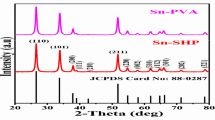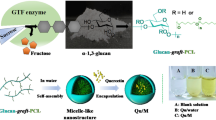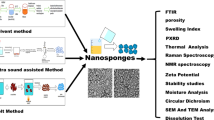Abstract
An oleic acid-grafted chitosan oligosaccharide (CSO-OA) with different degrees of amino substitution (DSs) was synthesized by the 1-ethyl-3-(3-dimethylaminopropyl) carbodiimide (EDC)-mediated coupling reaction. Fourier transform infrared spectroscopy (FT-IR) suggested the formation of an amide linkage between amino groups of chitosan oligosaccharide and carboxyl groups of oleic acid. The critical aggregation concentrations (CACs) of CSO-OA with 6%, 11%, and 21% DSs were 0.056, 0.042, and 0.028 mg·mL−1, respectively. Nanoparticles prepared with the sonication method were characterized by means of transmission electron microscopy (TEM) and Zetasizer, and the antibacterial activity against Escherichia coli and Staphylococcus aureus was investigated. The results showed that the CSO-OA nanoparticles were in the range of 60–200 nm with satisfactory structural integrity. The particle size slightly decreased with the increase of DS of CSO-OA. The antibacterial trial showed that the nanoparticles had good antibacterial activity against E. coli and S. aureus.
Similar content being viewed by others
References
Ananthapadmanabhan K P, Goddard E D, Turro N J, Kuo P L (1985). Fluorescence probes for critical micelle concentration. Langmuir, 1(3): 352–355
Ben-Shalom N, Ardi R, Pinto R, Aki C, Fallik E (2003). Controlling gray mould caused by Botytis cinerea in cucumber plants by means of chitosan. Crop Protection, 22(2): 285–290
Choi B K, Kim K Y, Yoo Y J, Oh S J, Choi J H, Kim C Y (2001). In vitro antimicrobial activity of a chitooligosaccharide mixture against Actinobacillus actinomycetemcomitans and Streptococcus mutans. International Journal of Antimicrobial Agents, 18(6): 553–557
Chung Y C, Wang H L, Chen Y M, Li S L (2003). Effect of abiotic factors on the antibacterial activity of chitosan against waterborne pathogens. Bioresource Technology, 88(3): 179–184
Esquenet C, Terech P, Boue F, Buhler E (2004). Structural and rheological properties of hydrophobically modified polysaccharide associative networks. Langmuir, 20(3): 3583–3592
Helander IM, Nurmiaho Lassila E L, Ahvenainen R, Rhoades J, Roller S (2001). Chitosan disrupts the barrier properties of the outer membrane of gram-negative bacteria. International Journal of Food Microbiology, 71(2,3): 235–244
Hirano S, Nagao N (1989). Effects of chitosan, pectic acid, lysozyme and chitinase on the growth of several phytopathogens. Agricultural and Biological Chemistry, 53(11): 3065–3066
Hu F Q, Ren G F, Yuan H, Du Y Z, Zeng S (2006). Shell cross-linked stearic acid grafted chitosan oligosaccharide self-aggregated micelles for controlled release of paclitaxel. Colloids and Surfaces B: Biointerfaces, 50(2): 97–103
Hu F Q, Zhao M D, Yuan H, You J, Du Y Z, Zeng S (2006). A novel chitosan oligosaccharide-stearic acid micelles for gene delivery: Properties and in vitro transfection studies. International Journal of Pharmaceutics, 315(1,2): 158–166
Jeon Y J, Kim S K (2000). Production of chitooligosaccharides using an ultrafiltration membrane reactor and their antibacterial activity. Carbohydrate Polymers, 41(2): 133–141
Kendra D F, Christian D, Hadwiger L A (1989). Chitosan oligomers from Fusarium solani/pea interactions, Chitinase/beta-glucanase digestion of sporelings and fungal wall chitin actively inhibit fungal growth and enhance disease resistance. Physiological and Molecular Plant Pathology, 35(3): 215–230
Koide S S (1998). Chitin-chitosan: Properties, benefits and risks. Nutrition Research, 18(6): 1091–1101
Le Tien C, Lacroix M, Ispas-Szabo P, Mateescu M A (2003). N-acylated chitosan: hydrophobic matrices for controlled drug release. Journal of Controlled Release, 93(1): 1–13
Li Y Y, Chen X G, Liu C S, Cha D S, Park H J, Lee C M (2007). Effect of the molecular mass and degree of substitution of oleoylchitosan on the structure, rheological properties, and formation of nanoparticles. Journal of Agricultural and Food Chemistry, 55: 4842–4847
Liu C G, Fan W W, Chen X G, Liu C S, Meng X H, Park H J (2007). Self-assembled nanoparticles based on linoleic-acid modified carboxymethyl-chitosan as carrier of adriamycin (ADR). Current Applied Physics, 7(Suppl 1): e125–e129
Liu X F, Guan Y L, Yang D Z, Li Z, Yao K D (2001). Antibacterial action of chitosan and carboxymethylated chitosan. Journal of Applied Polymer Science, 79(7): 1324–1335
Mitra S, Gaur U, Ghosh P C, Maitra A N (2001). Tumour targeted delivery of encapsulated dextran-doxorubicin conjugate using chitosan nanoparticles as carrier. Journal of Controlled Release, 74(1–3): 317–323
Qi L F, Xu Z R, Jiang X, Hu C H, Zou X F (2004). Preparation and antibacterial activity of chitosan nanoparticles. Carbohydrate Research, 339(16): 2693–2700
Qin C Q, Du Y M, Xiao L, Zhan L, Gao X H (2002). Enzymic preparation of water-soluble chitosan and their antitumor activity. International Journal of Biological Macromolecules, 31(1–3): 111–117
Qin C Q, Zhou B, Zeng LT, Zhang Z H, Liu Y, Du Y M, Xiao L (2004). The physicochemical properties and antitumor activity of cellulasetreated chitosan. Food Chemistry, 84(1): 107–115
Roller S, Covill N (1999). The antifungal properties of chitosan in laboratory media and apple juice. International Journal of Food Microbiology, 47(1,2): 67–77
Shigemasa Y, Matsuura H, Sashiwa H, Saimoto H (1996). Evaluation of different absorbance ratios from infrared spectroscopy for analyzing the degree of deacetylation in chitin. International Journal of Biological Macromolecules, 18(3): 237–242
Smith P K, Mallia A K, Hermanson G T (1980). Colorimetric method for the assay of heparin content in immobilized heparin preparations. Analytical Biochemistry, 109(2): 466–473
Sudarshan N R, Hoover D G, Knorr D (1992). Antibacterial action of chitosan. Food Biotechnology, 6(3): 257–272
Suzuki K, Mikami T, Okawa Y, Tokoro A, Suzuki S, Suzuki M (1986). Antitumor effect of hexa-N-acetylchitohexaose and chitohexaose. Carbohydrate Research, 151: 403–408
Uchida Y, Izume M, Ohtakara A (1989). Preparation of chitosan oligomers with purified chitosanase and its application. In: Skjåk-Bræk G, Anthonsen T, Sandford P, eds. Chitin and chitosan: Sources, chemistry, biochemistry, physical properties and applications. London: Elsevier, 373–382
Vishu Kumar A B, Varadaraj M C, Lalitha R G, Tharanathan R N (2004). Low molecular weight chitosans: preparation with the aid of papain and characterization. Biochimica et Biophysica Acta-General Subjects, 1670(2): 137–146
Xing K, Chen X G, Li Y Y, Liu C S, Liu C G, Cha D S, Park H J (2008). Antibacterial activity of oleoyl-chitosan nanoparticles: A novel antibacterial dispersion system. Carbohydrate Polymers, 74(1): 114–120
Young D H, Kauss H (1983). Release of calcium from suspension cultured Glycine max cells by chitosan, other polycations, and polyamines in relation to effects on membrane permeability. Plant Physiology, 73: 698–702
Author information
Authors and Affiliations
Corresponding author
Rights and permissions
About this article
Cite this article
Huang, L., Cheng, X., Liu, C. et al. Preparation, characterization, and antibacterial activity of oleic acid-grafted chitosan oligosaccharide nanoparticles. Front. Biol. China 4, 321–327 (2009). https://doi.org/10.1007/s11515-009-0027-4
Received:
Accepted:
Published:
Issue Date:
DOI: https://doi.org/10.1007/s11515-009-0027-4




